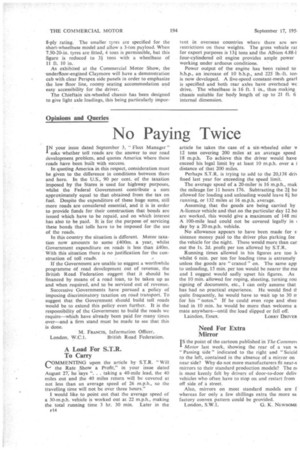Opinions and Queries
Page 104

If you've noticed an error in this article please click here to report it so we can fix it.
No Paying Twice
IN your issue dated September 3, "Fleet Manager" I asks whether toll roads are the answer to our road development problem, and quotes America where these roads have been built with success.
In quoting America in this respect, consideration must be given to the difference in conditions between there and here. In the U.S., 90 per cent. of the taxation imposed by the States is used for highway purposes, whilst the Federal Government contribute a sum approximately equal to that obtained from the tax on fuel. Despite the expenditure of these huge sums, still more roads are considered essential, and it is in order to provide funds for their construction that bonds are issued which have to be repaid, and on which interest has also to be paid. It is for the purpose of servicing these bonds that tolls have to be imposed for the use of the roads.
In this country the situation is different. Motor taxation now amounts to some £400m. a year, whilst Government expenditure on roads is less than £.40m. With this situation there is no justification for the construction of toll roads.
If the Government are unable to suggest a worthwhile programme of road development out of revenue, the British Road Federation suggest that it should be financed by means of a road loan, to be taken up as and when required, and to be serviced out of revenue.
Successive Governments have pursued a policy of imposing discriminatory taxation on road transport. To suggest that the Government should build toll roads would be to extend this policy even further. It is the responsibility of the Government to build the roads we require—which have already been paid for many times over—and a firm stand must be made to see that this is done.
. M. FRANCIS, Information Officer,
London, W.C.1. British Road Federation,
A Load For S.T.R. To Carry
COMMENTING upon the article by S.T.R. "Will the Rate Show a Profit," in your issue dated August 27, he Says ". . taking a 40-mile lead, the 40 miles out and the 40 miles return will be covered at not less than an average speed of 26 m.p.h., so the travelling time will not be over three hours."
would like to point out that the average speed of a 30-m.p.h. vehicle is worked out at 22 m.p.h., making the total running time 3 hr. 30 min. Later in the article he takes the case of a six-wheeled oiler 12 tons covering 200 miles at an average speed 18 m.p.h. To achieve this the driver would have exceed his legal limit by at least 10 m.p.h. over a I distance of that 200 miles.
Perhaps S.T.R. is trying to add to the 20,138 dri% fined last year for exceeding the speed limit.
The average speed of a 20-miler is 16 m.p.h., mak the mileage for 11 hours 176. Subtracting the 2/ho allowed for loading and unloading would leave 81 ho running, or 132 miles at 16 m.p.h. average.
Assuming that the goods are being carried by A-licence vehicle and that on the particular day 12 ho are worked, this would give a maximum of 148 ml A 100-mile lead could not be covered legally in day by a 20-m.p.h. vehicle.
No allowance appears to have been made for s. sistence money paid to the driver plus parking fee the vehicle for the night. These would more than can out the is. 2d. profit per ton allowed by S.T.R, Running times allowed in his figures are too whilst 6 mm. per ton for loading time is extremely unless the goods are " craned " on. The same app. to unloading, 15 mm. per ton would be nearer the ma and I suggest would sadly upset his figures. As the 10 mm. allowed for roping, sheeting, turning rou signing of documents, etc., I can only assume that has had no practical experience. He would find tF quite frequently, he would have to wait up to 30 n for his "notes." If he could even rope and shee load in 10 min. he would be more than welcome a mate anywhere—until the load slipped or fell off.
Laindon, Essex. LORRY DRIVER
Need For Extra Mirror
IS the point of the cartoon published in The Commerc I Motor last week, showing the rear of a van w " Passing side" indicated to the right and " Suicid to the left, contained in the absence of a mirror on near side? Why do not more manufacturers fit near-s mirrors to their standard production models? The n1 is most keenly felt by drivers of door-to-door deliv vehicles who often have to stop on and restart from off side of a street.
Also, mirrors on most standard models are f whereas for only a few shillings extra the more sa factory convex pattern could be provided.
London, S.W.1. G. K. NEWSOME












































































































































































































